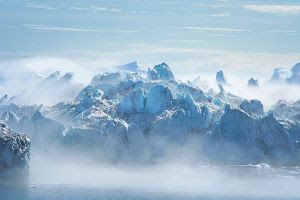WHILE YOU WERE ON VACATION, A CHUNK OF ICE THE SIZE OF AN ASTEROID FELL INTO THE OCEAN
With Arctic temperatures rising rapidly thanks to climate change, Greenland’s ice sheet is melting and raising sea levels.
An iceberg in Greenland. (Photo: Michael Schwab/Getty Images)
Emily J. Gertz is TakePart’s associate editor for environment and wildlife.
Imagine Manhattan buried under a thousand feet of ice. That’s how much of Greenland’s Jakobshavn Glacier fell into the Arctic Ocean last week, becoming a 7.8-square-mile iceberg.
(Photos: Courtesy NASA.gov)
“As a single event, this is a fairly rare size,” said Twila Moon, an ice sheet scientist at the University of Oregon. But the phenomenon isn’t unusual, she said, because glaciers in Greenland “pulse” seasonally. That means they break off at their edges and retreat inland in summer, and move back toward the ocean in winter.
Advertisement
Still, the ongoing retreat of the Jakobshavn Glacier is another sign that climate change is further destabilizing the ice sheet covering Greenland, one of the world’s biggest repositories of freshwater. Even with temperatures in the Arctic rising at nearly twice the global average, scientists have been surprised in recent years by the fast melt rate of Greenland’s land-bound ice, which contributes to sea-level rise.
Since the 1990s, the Jakobshavn has failed to regain the ground it loses in summer, and the glacier’s leading edge is now further inland than it has been in 135 years of record-keeping, said Moon.
Between 1850 and 1964, the Jakobshavn Glacier, Greenland’s largest outlet glacier, retreated at a steady rate of around 984 feet a year, according to NASA. After holding steady for more than 30 years, in 2001 the ice front retreated rapidly by around 9,800 feet (1.9 miles) and has continued to recede dramatically almost every year since. (Image: NASA)
“It is not difficult to say that this continued retreat is in line with what we expect to happen with climate change, with the Jakobshavn as well as the many other glaciers around Greenland and the rest of the Arctic,” she added. “Unfortunately, I don’t think there are any glaciologists who were surprised by this event.”
NASA and European Space Agency satellites photographed the ice mass calving off the glacier between Aug. 14 and Aug. 16. The ESA estimated that the iceberg was 4,590 feet thick.
The United Nations climate agency has forecast that unless greenhouse gas emissions are cut sharply in the next 35 to 50 years, the ice sheets on both Greenland and West Antarctica will begin to completely collapse, speeding up rates of sea-level rise. Scientists estimate that together, they are losing 300 billion tons of ice annually owing to rising temperatures.
“I do think it’s important for people to understand that this not a surprise event,” Moon said. “This is a signal that is consistent with what we expect from climate change. It’s a reminder that we should act, not that we should give up.”








Follow Us!